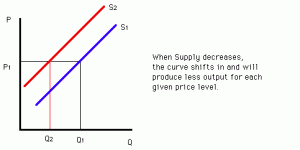Discussion on Bruce Dybvik’s “The Ripple Effect: Cost of gas and groceries go hand in hand” (Dunn County News, July 30, 2008).
More than ever before, the world is more interconnected. Events occurring in one place do not only have direct effects to the surrounding area but may have subtle indirect effects in different parts of the planet. Like a pebble thrown into a pond, one factor may send waves of positive or negative influence to multiple economic sectors. One such example of this phenomena is explored by Dybvik’s discussion of the effect of gas prices on food prices in the United States.
According to Dybvik, this ripple effect is known as “wavefunction” and comes from quantum physics. He explains that in wavefunction “nothing happens in isolation, or simply that everything consists of and is affected by waves.” Dybvik relates this effect to the positive correlation between rising prices for petroleum and food in 2008.
A recent study from the Wisconsin Farm Bureau Federation found that “retail prices of 20 food items in 26 communities showed an increase of 4.3 percent in the second quarter” (2008). The same article concluded oil prices play a significant role in the rising cost of food. Not only does the rising cost of fuel increase shipping costs, but many products are also shipped in petroleum-based packaging that has also become more expensive. Supermarkets are forced to pass these higher costs onto the consumer in the form of increased prices for food. This effect is seen in the rise of prices of corn-based food products because of its heavy reliance on energy-dependent processing that is becoming increasingly expensive.
In addition to increasing the cost of food, higher oil prices have also affected consumer and retailer behavior. Tied by the inelastic demand for food, consumers have found themselves searching for any means to reduce their total expenditure in the face of rising prices. Dybvik found that supermarkets have seen a decrease in the frequency of purchases but increase in the amount purchased. Experts attribute this to individuals’ desire to save on gas. There is also a shift to an increase in the purchase of private label products. Supermarkets themselves have modified their purchase behavior by purchasing locally and less frequently to reduce the impact of shipping expense on price. Consumers are now finding themselves concentrating on foods that will stretch their budgets and last longer than a single meal.
Dybvik pulls on a Wisconsin Farm Bureau Federation report that states, “Oil prices are at the heart of inflation seen in all sectors of the economy, including food.” He goes on to explain how the price of oil has changed consumer buying behavior, increased retail prices, and, even, altering food preparation. It is very clear that oil prices have a large effect on the price of food and food-related products because it is a large input in production; however, external supply and demand factors separate from oil prices may cause movement in the economy.
Historical data show that oil prices and inflation have not always been perfectly correlated. An Investopedia article, explains that the connection between oil prices and inflation is seen in the 1970s but has significantly decreased since then. Dybvik’s statement is also too general and fails to account for every sector of the economy. Recently, inflation, in general, has been low. Although it is true that retail and food sectors have been increasing their prices to incorporate higher oil costs, Mark Lacter, a business analyst for KPCC, a Los Angeles radio station, points out in an interview that the housing sector is one part of the economy which price is not affected by oil.
At the time Dybvik’s article is written, the housing bubble is just about to burst. We all know the story. Oil was an input in the production of houses but since buyers were no longer willing to purchase houses, quantity supplied exceeded quantity demanded pushing the price of houses to be lower despite increasing oil prices.
The unfortunate event of the Japanese tsunami of 2011 aptly illustrates the supply and demand model. More specifically, producers of various electronic products, whose facilities have been critically damaged as a result of the natural disaster, have had to persevere as best as they could. While countless companies attest to the severity of the impacts, producers such as Toshiba who make electronic chips – used to store data for electronic devices such as digital cameras and smartphones – may be one of the most critically affected. As a result, prices jumped from $7.30 to $10, demonstrating the direct, short-term result of the tsunami.
The following S&D diagram illustrates this point.

At this point, it is important to realize that the demand for the microchips are relatively inelastic: the change in the quantity demanded is smaller relative to the change in prices. This inelasticity could be explained by the necessity of the chips in countless products, such as: flat-panel displays and other components used in devices like computers, tablets, digital cameras, blu-ray players and televisions. The following diagram illustrates the difference between elastic and inelastic demand.
The left diagram illustrates how price is relatively unresponsive (inelastic) to the corresponding decrease in quantity, whereas the right diagram shows how even a small change in quantity triggers a heavy increase in price (elastic).
Moreover, it is worth mentioning how suppliers of other products are affected. For example, automakers who depend on internal components from companies such as those aforementioned also face the inability to produce, and thus challenge to meet demand. Toyota, along with almost every other Japanese automakers, was forced to halt production as they were unable to receive the necessary components for their vehicles from their suppliers. IHS iSuppli, a research firm, estimated that the plant production shut-downs/stoppages could cut automaker output by up to 250,000.
Posted by Andrew, Anne, Nico and Will (Section 4)
Resources:
http://www.investopedia.com/ask/answers/06/oilpricesinflation.asp#axzz1kDVhkUDi
http://www.scpr.org/programs/business–update–with–mark–lacter/2012/01/10/inflation–and–oil–prices/
http://www.nytimes.com/2011/03/15/business/global/15supply.html?pagewanted=all
http://www.time.com/time/business/article/0,8599,2059444,00.html
http://www.uri.edu/artsci/newecn/Classes/Art/INT1/Eco/S_D/Gifs/supply.in.gif
http://www.google.com/imgres?um=1&hl=en&sa=N&biw=1440&bih=799&authuser=0&tbm=isch&tbnid=GJoPSSYEuu–KOM:&imgrefurl=http://www.uri.edu/artsci/newecn/Classes/Art/INT1/Mic/Elast/index.elast.html&docid=tqvzHxPa9_-gkM&imgurl=http://www.uri.edu/artsci/newecn/Classes/Art/INT1/Mic/Gif/elasticity0.gif&w=487&h=201&ei=wtsdT8i8FPLgsQLg27SdCw&zoom=1&iact=hc&vpx=137&vpy=286&dur=3008&hovh=144&hovw=350&tx=111&ty=110&sig=110172692780708428366&page=3&tbnh=76&tbnw=184&start=59&ndsp=35&ved=1t:429,r:14,s:59
